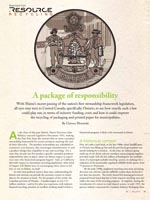
With Maine’s recent passing of the nation’s first stewardship framework legislation,all eyes may turn to Central Canada, specifically Ontario, to see how exactly such a lawcould play out, in terms of industry funding, costs and how it could improvethe recycling of packaging and printed paper for municipalities.
At the close of this past March, Maine Governor John Baldacci enacted Legislative Document 1631, making the Pine Tree State the nation’s first to enact a product stewardship framework for certain products reaching the end of their lifecycles. The product stewardship act, scheduled to commence next January, also encourages manufacturers to seek a product design that simplifies re-use and recycling. For a state that already has five product-specific extended producer responsibility laws in place, what can Maine expect to experience once this framework program begins? And, as California did with respect to electronics recycling legislation, what kind of impact will Maine have in encouraging other states to follow, or not to follow, its lead?
As with most political matters these days, understanding the history and interests can provide the necessary context to clearly discern the situation at hand. For the purpose of this article, the Canadian province of Ontario – Canada’s largest at over 13.1 million residents – and its five plus year experience with industryfinanced recycling, provides an excellent working model of how a framework program is likely to be structured in Maine.

